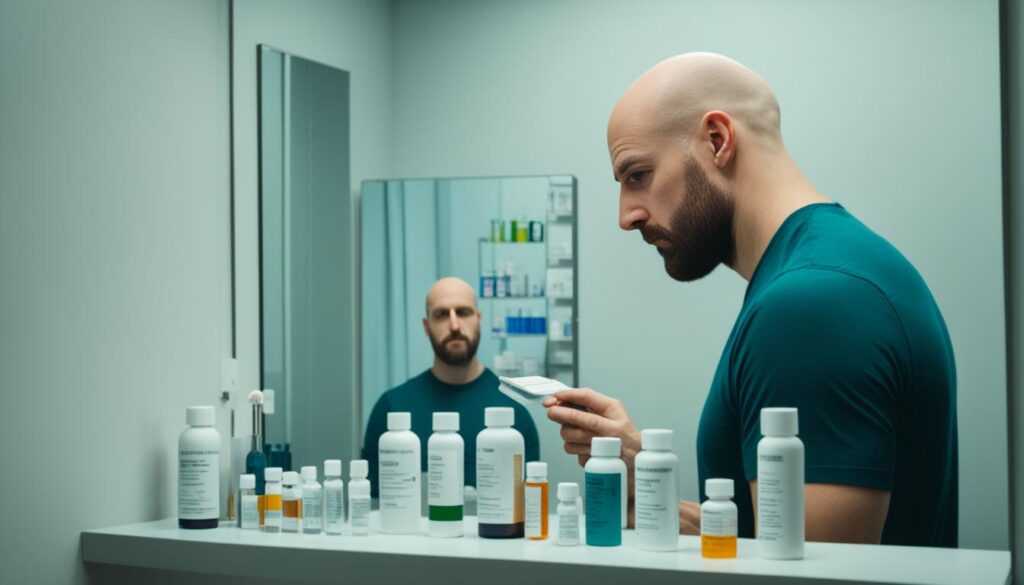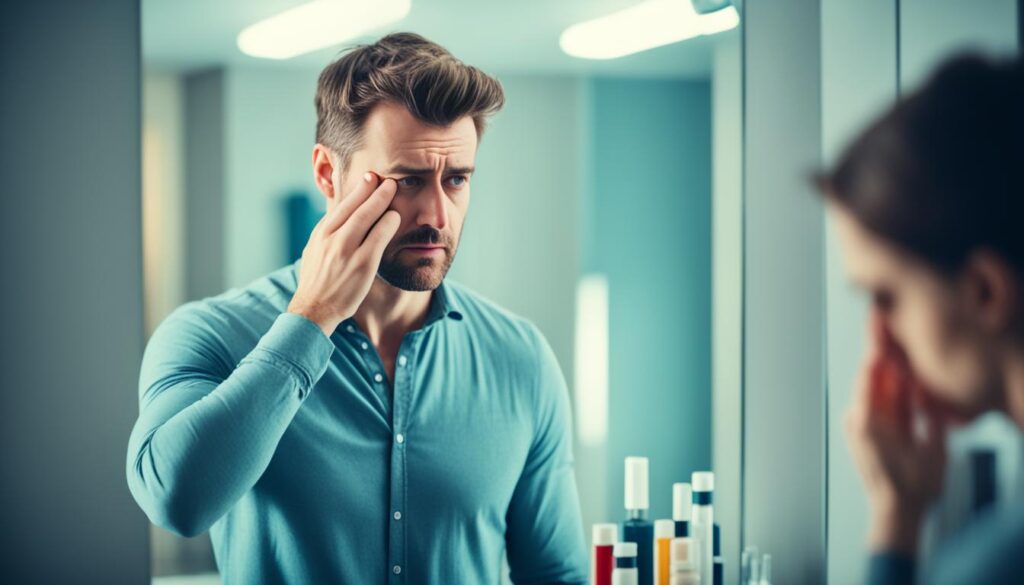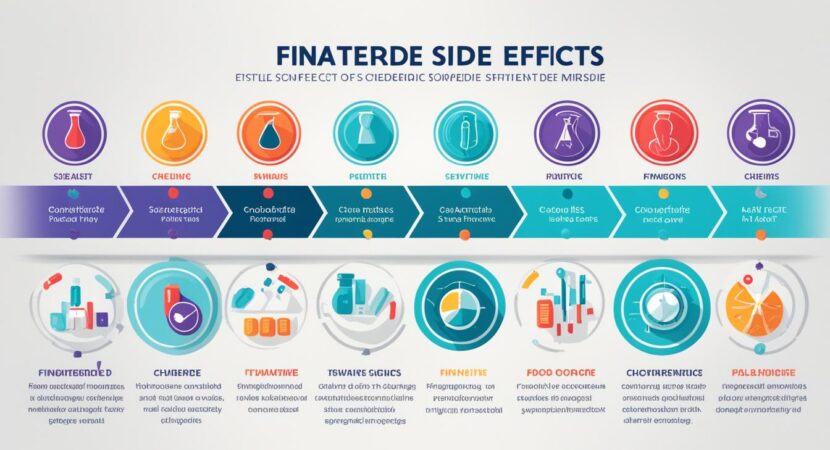As a trusted medication for combatting hair loss, finasteride has become a beacon of hope for many. However, it is imperative to address the finasteride risks and adverse effects of finasteride that may accompany its use. Understanding the finasteride safety profile is not just a precaution but a necessary step in responsible health care. We are committed to providing you with the insights needed to ensure your well-being as your hair regrowth journey begins. Let’s delve into the facts and help you make an informed decision.
Key Takeaways
- Be aware of the potential finasteride risks before starting the medication.
- Understanding adverse effects of finasteride is critical for your safety.
- Make informed decisions about hair loss treatments based on finasteride safety and efficacy.
- Consult with healthcare professionals regarding the benefits and risks of finasteride treatment.
- Stay informed about new research and updates on finasteride’s impact on health.
Understanding Finasteride and Its Uses in Hair Loss Treatment
When exploring options for hair loss treatment finasteride often surfaces as a prominent solution. Finasteride for hair loss is widely acknowledged for its effectiveness in combating this common issue. In this segment, we’ll gain a deeper grasp of what finasteride is, its operation in preventing hair thinning, and the benefits of finasteride for those seeking hair regrowth interventions.
What is Finasteride?
Finasteride is a prescription drug initially created to treat prostate conditions such as benign prostatic hyperplasia (BPH). However, its efficacy in promoting hair regrowth was quickly noted, which led to its approval for treating male pattern baldness at lower doses. The medication is available under various brand names and is designed for long-term use to maintain its benefits.
How Finasteride Works Against Hair Loss
The mechanism of action for finasteride for hair loss lies in its ability to hinder the conversion of testosterone to dihydrotestosterone (DHT) by blocking the enzyme 5-alpha reductase. DHT plays a key role in hair loss; it shrinks hair follicles, which eventually leads to thinning hair and baldness. By reducing DHT levels, finasteride allows for the stabilization of hair loss and regrowth of hair in areas affected by male pattern hair loss.
Benefits of Finasteride for Hair Regrowth
Users who have incorporated hair loss treatment finasteride in their regimens often report a significant pause in hair loss progression and sometimes an increase in hair density. Most significantly, finasteride has the potential to enhance one’s self-image and confidence, which are often undermined by hair loss. The table below encapsulates the core advantages users might experience:
| Benefit | Description |
|---|---|
| Reduction in Hair Loss | Slows down the rate of hair thinning and balding noticeably. |
| Promotion of Hair Regrowth | Stimulates regrowth of hair, improving hair density and fullness over time. |
| Usability | Orally administered once daily, offering convenience and ease of integration into daily routines. |
| Psychological Benefits | Helps restore self-esteem and reduces anxiety associated with hair loss. |
Recognizing the benefits of finasteride is vital, but it’s equally important to consult with healthcare professionals to understand its applicability to your specific situation. The decision to include finasteride in your hair care regimen should be informed and tailored to your personal healthcare needs.
Comprehensive Look at Finasteride Side Effects
Awareness of the potential finasteride side effects is essential for anyone considering this treatment for hair loss. Reported adverse reactions to finasteride range in severity and frequency, impacting users in different ways. We delve into the most common side effects, offering a detailed perspective on what one may experience and the implications of these reactions.

Research indicates that while many individuals tolerate finasteride well, some may encounter undesirable side effects. These can include, but are not limited to:
- Sensitivity and enlargement of breast tissue
- Skin rashes
- Swelling of the lips and face
- Depressive symptoms
- Testicular pain
Notably, some side effects may persist even after discontinuation of the drug, a phenomenon known as “Post-Finasteride Syndrome.” Below is a table summarizing the frequency of common side effects as reported by users:
| Side Effect | Estimated Frequency |
|---|---|
| Erectile Dysfunction | Up to 1.3% |
| Decreased Libido | Up to 1.8% |
| Ejaculation Disorder | Up to 1.2% |
| Gynecomastia | Less than 0.5% |
| Depression | Insufficient Data for an Accurate Estimate |
It is crucial for patients and healthcare providers to discuss the finasteride side effects thoroughly to weigh the benefits and risks effectively. Users are encouraged to report any adverse reactions to finasteride to their healthcare provider immediately should they arise.
While some side effects are reversible upon cessation of the medication, long-term effects are still under investigation. Ongoing studies continue to examine the breadth and persistence of certain side effects to better understand the full scope of finasteride’s safety profile.
Ultimately, understanding these side effects is a cornerstone of making an informed decision regarding the use of finasteride for managing hair loss. As with any medication, individual experiences will vary, and it is important to monitor one’s health and consult with healthcare professionals throughout the treatment process.
Sexual Health Concerns Related to Finasteride
While finasteride may be heralded for its efficacy in hair loss treatment, its potential to cause sexual side effects cannot be overlooked. These side effects, concerning many individuals under this medication, have raised alarm within the medical community. Their impact on quality of life and overall well-being is a matter that demands careful attention and understanding.
Impotence and Decreased Libido
Among the reported sexual side effects of finasteride, impotence from finasteride and libido decrease due to finasteride are perhaps the most distressing for patients. Impotence, or the inability to maintain an erection, coupled with a diminished sex drive, marks a serious dilemma for those affected. The medical literature suggests a varying incidence rate for these side effects, yet the concern remains tangible among users and health care practitioners alike.
Erectile Dysfunction and Ejaculation Disorders
The concerns extend to erectile dysfunction, a persistent trouble with achieving or sustaining an erection, as well as ejaculation disorders, referring to delayed ejaculation or reduced semen volume. It is no small matter for the men experiencing these symptoms, and these concerns have rightfully gained traction in discussions about finasteride as a hair loss solution.
| Sexual Side Effect | Prevalence (Estimated) |
|---|---|
| Decreased Libido | 1.8% |
| Erectile Dysfunction | 1.3% |
| Ejaculation Disorders | 1.2% |
The existence of these side effects highlights the need for patients to have frank, informative conversations with their healthcare providers regarding the potential risks before embarking on a treatment plan which includes finasteride. It is imperative for users to be closely monitored for any changes in their sexual function and to discuss any persisting symptoms with their medical provider without delay.
Finasteride and Mental Health: Potential Psychological Effects
While the effectiveness of finasteride in treating hair loss is well-documented, less attention is often paid to the finasteride psychological side effects. Recent research has begun to shed light on the potential mood changes and other psychological impacts this medication can have. For those considering or currently using finasteride, it is crucial to be aware of the mental health implications that may accompany its use.
The discussion around mood changes due to finasteride has become increasingly relevant, as patients have reported a range of emotional and cognitive changes while on the medication. Monitoring these psychological side effects is essential, and healthcare professionals should be informed of any significant shifts in mental well-being.

- Anxiety: Some users report increased levels of anxiety that they believe are directly linked to their finasteride use.
- Depression: There are instances where users have experienced depressive episodes, emphasizing the need for further review and discussion with healthcare providers.
- Irritability: Mood changes, such as heightened irritability, have been noted, which can affect interpersonal relationships and overall quality of life.
- Cognitive Impairment: Although less common, some individuals have reported issues with memory and concentration.
These psychological concerns are crucial to understanding the comprehensive impact of finasteride, beyond the physical side effects that are more commonly discussed. It highlights the importance of a holistic approach to treatment, considering both physical and mental health outcomes. Below is a table summarizing the potential psychological effects associated with finasteride use:
| Psychological Effect | Description | Considerations |
|---|---|---|
| Anxiety | Increased tension and nervousness that may interfere with daily activities. | Patients should monitor their anxiety levels and seek professional advice if symptoms persist. |
| Depression | Mood disorder characterized by persistent feelings of sadness and loss of interest. | Depressive symptoms warrant immediate attention and evaluation by a healthcare provider. |
| Irritability | Shortened temper and impatience which can affect social interactions. | May need to assess if these mood changes significantly impact relationships. |
| Cognitive Impairment | Difficulty with memory, focus, or other thought processes. | Consider cognitive screening and discuss any changes with healthcare professionals. |
Finasteride treatment should involve not only tracking the progress of hair regrowth but also being vigilant about any finasteride psychological side effects. Vigilance and open communication with medical professionals can help manage any adverse psychological effects, ensuring a more positive treatment experience.
The Impact of Finasteride on Hormonal Balance
Finasteride’s role in treating hair loss extends beyond the surface to involve intricate hormonal interactions within the body. An essential aspect of understanding a medication like finasteride is recognizing its influence on hormonal balance, particularly concerning male physiology. As finasteride modifies certain hormonal pathways, it’s crucial to consider the finasteride hormonal side effects that may occur as a result of these changes. In this section, we scrutinize the significant alterations in testosterone levels and the related risk of gynecomastia emerging from the use of finasteride, outlining the need for awareness and consideration of these potential health implications.
Changes in Testosterone Levels
At the heart of finasteride‘s mechanism is its impact on the conversion of testosterone into dihydrotestosterone (DHT). By inhibiting this conversion, finasteride effectively reduces DHT levels in the scalp, which is beneficial for hair retention and growth. However, an unintended consequence might be the alteration of hormonal balance, including testosterone changes from finasteride. While this adjustment is central to finasteride’s effect against hair loss, it’s important to monitor for any resulting physiological or symptomatic changes that might indicate a deeper hormonal disturbance.
Finasteride and the Risk of Gynecomastia
Among the potential finasteride hormonal side effects is the development of gynecomastia—or an enlargement of breast tissue in men. This sensitive condition has been associated with finasteride use due to the drug’s hormonal effects, leading to an imbalance that may favor the development of breast tissue. The link between gynecomastia and finasteride necessitates a vigilant approach to treatment, encouraging patients to report any changes in breast tissue to their healthcare provider promptly. Understanding these side effects is critical to managing expectations and prioritizing health when opting for finasteride as a hair loss treatment strategy.


Reply